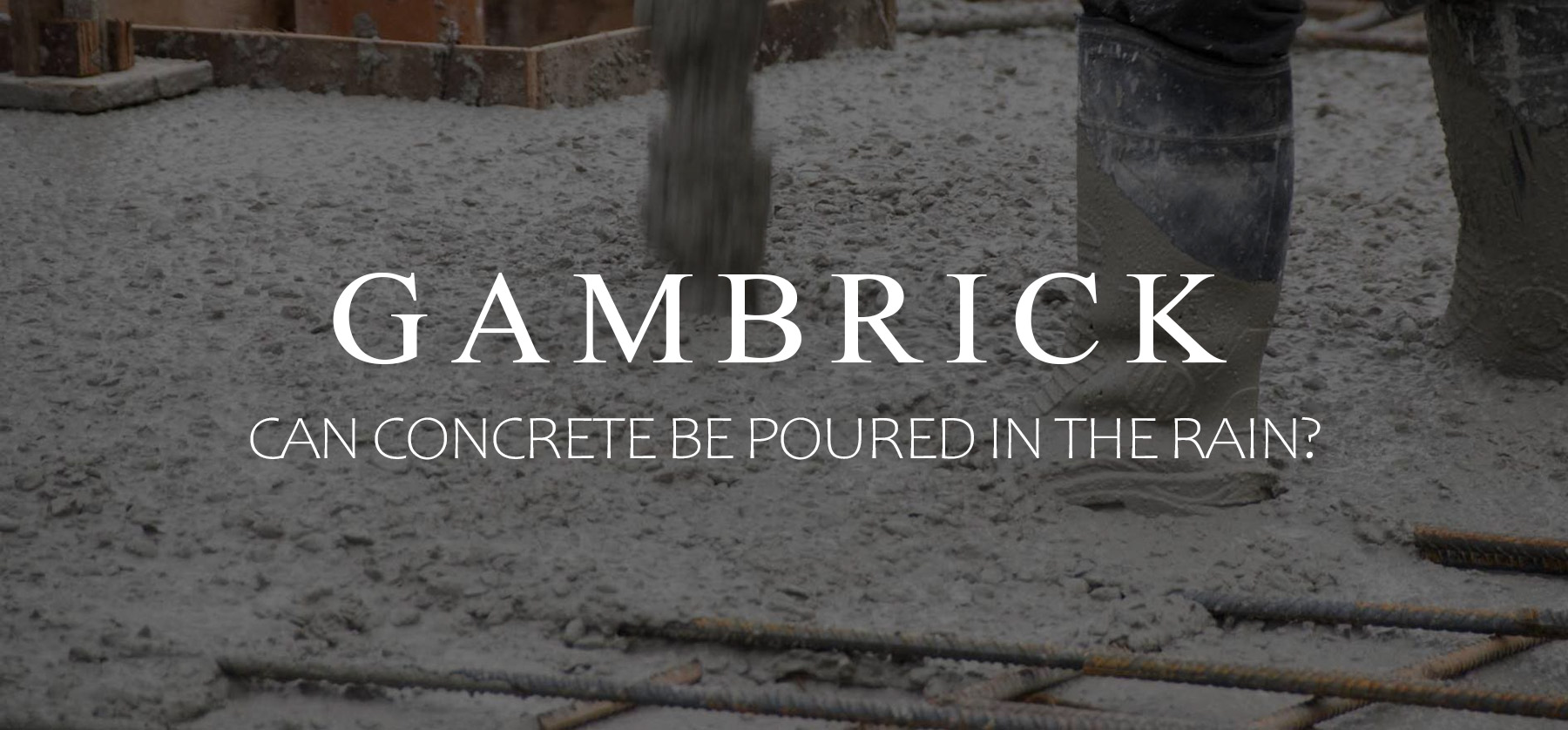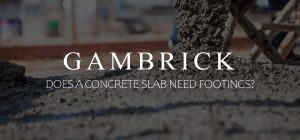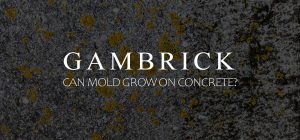
Can Concrete Be Poured In The Rain?
I’ve been a mason and home builder for over 25 years and can tell you firsthand that concrete can be poured in the rain, but it should be a light rain or a drizzle. A heavy down-pour is too much water in too short a period of time. All that water and can weaken the concrete while the force of the drops ruins the slab’s finish.
Concrete initially dries and hardens through a chemical reaction called hydration and curing, which takes 28 days to fully cure. Since water is an important part of making concrete, a little extra won’t necessarily ruin the slab, but too much will.
When concrete cures it dries, which means water evaporates out. This leaves behind tiny tubes that create concrete pores. The more water that’s present in the wet concrete, the more porous your slab will be.
A warm dry day is definitely better than a rainy one for pouring concrete. But if I have to pour concrete and there’s a chance of light rain I usually stay on schedule and pour. But there are some precautions I take to protect the concrete.
Make sure you have enough tarps to completely cover the concrete. Keep the site dry before you pour and never pour concrete on wet ground. Then cover the slab once the concrete is poured and troweled.
Ensure there’s good drainage around the concrete. Even a light rain can build up, sending water into the fresh concrete. Even underground concrete can be affected by heavy rain because it absorbs groundwater. Divert water around the slab with drain pipes or digging swells.
Before covering the top of the slab, push excess water off with your float and cover it quickly. Excess water on freshly poured concrete can draw out cement and weaken the slab.
What Happens If It Rains When You Pour Concrete?
Heavy rain falling on top of freshly laid concrete can damage the surface. Even worse, if extra water seeps into the concrete mix, it can weaken the slab. Properly mixed concrete should contain the correct amount of water before you start pouring. Additional water inside the slab will only cause problems.
I’ve been in this situation many times throughout my career as a builder and a mason. I can tell you from first hand experience that pouring concrete in a light rain is OK. But you have to work fast, be efficient and prep the site before and after the pour.
Keep the ground dry by covering it with tarps before you pour. Then cover the fresh concrete with tarps once you’re done finishing the surface. Make sure to broom or float excess water off the surface right before you tarp it.
Don’t pour in a heavy rain unless the entire site is covered by tarps at all times. Heavy rain will ruin a slab’s finish and weaken the concrete.
Cover The Area With Tarps
Concrete should be mixed with just enough water to activate all the cement. Too much water weakens the concrete by watering down the cement. Rain and ground water can provide this excess water.
Rain damages fresh concrete in two ways:
- Too much water seeping into the slab will eventually weaken the concrete.
- The force of the rain drops can damage a concrete surface.
It’s very important to never pour concrete onto a wet surface or into a trench filled with water. Some of the water can be absorbed into the concrete which can weaken it. If you’re going to pour concrete in the rain make sure the area is dry by covering it with tarps before it starts raining.
Don’t try to soak up water with concrete. The concrete should be properly mixed before you start pouring. Any additional water on the ground will only cause problems. Once you mix the concrete it doesn’t need any more water.
If you’re pouring concrete and there’s a chance of rain, make sure to have lots of tarps on site. Cover the entire area with tarps and don’t remove them until you’re ready to start pouring concrete.
Divert Ground Water Around The Concrete
Covering the area with tarps keeps the rain water out from above but it doesn’t help with runoff. Ground water that builds up around the slab can eventually run down hill and into your fresh concrete.
Every job site is a little different. If you’re pouring concrete on flat grade where runoff won’t be an issue then don’t worry about it. But if your site is downhill you may have to divert some water runoff.
I always check the grade and the entire site around wherever I pour fresh concrete. If rainwater will potentially run into my concrete I dig a small swell, use corrugated drain pipes or build a barrier of dirt to divert the water.
If water runoff hits the slab that area could be compromised. Especially if it’s heavy and gets on top of the concrete. Even though you’ve covered the slab from above, some ground water runoff can still ruin it so be prepared.
Inspect the home’s gutter system. Base on the grade it may seem like water won’t runoff into your slab but the gutter system may change that. I’ve seen slabs ruined by underground gutter drainage that went unseen until it was too late.
Don’t Pour Concrete In Heavy Rain
It’s OK to pour concrete in a light rain if you take precautions. But you should never pour in a heavy rain. Heavy rain is too much water in a short amount of time for the concrete to handle. And the rain drops are generally bigger which causes more damage to the concrete surface.
Concrete is a mix of cement, sand and stone mixed with water and some other additives. Altering the concrete mix ratio by adding more water can effect the entire slab. If you pour in heavy rain the result will typically be a weaker slab with an ugly finish. While some light water shouldn’t be a problem, buckets of rain will cause major problems.
I’ve seen many slabs ruined by heavy rain when masons poured thinking the rain would be light and it turned heavy. The concrete had to be torn out and completely redone. If there’s even a slight chance the rain could get bad it’s best to reschedule the pour.
The only way to safely pour concrete in a heavy rain is to completely cover the area with tarps. I’ve done it a few times with small slabs but I don’t recommend it.
Dry The Surface
When you’re done finishing the slab’s surface and about to cover the concrete with tarps, make sure to broom, squeegee or float off excess water first. Leaving too much standing water on top of a slab can leech cement.
When cement leeches to the surface it creates a weak brittle spot that’s prone to cracking. It can also draw stones from below up to the surface which creates a rocky appearance. If you’re trying to create a smooth concrete surface, cement leeching can ruin the area where it occurs.
Cover The Concrete
Once you’ve created drainage to handle runoff and kept the site dry with tarps, it’s time to pour and finish the slab. Work fast and efficiently because rain will be falling into the site and concrete as you work. Remember, pouring concrete in light rain is usually OK but don’t try it if the rain is heavy.
Immediately after you’re done finishing the concrete you should cover it with tarps again. I use stakes and long poles to keep tarps off the concrete surface. If a tarp touches the concrete it can leave a discoloration mark. I’ve seen entire slabs ruined because plastic tarps touched the concrete surface. They can create a look like tiger stripes.
Right before you tarp the concrete broom, squeegee or float excess water off the surface as best you can.
Check the concrete periodically for the first hour or two to make sure it’s drying properly. Because of the rain and moisture in the are concrete will dry slower. But this isn’t a bad thing. When concrete dries and cure slowly it actually produces a stronger slab with less surface cracks.
Protect The Concrete For 24 Hours
Whenever I pour concrete in the rain I leave the tarps on for about 24 hours. This provides enough time for the initial curing. After 24 hours the slab will be strong enough to handle foot traffic. After about a week you can park cars on the concrete.
When you pour concrete in the rain it will dry and cure slower. This is because of all the moisture in the air and on the concrete’s surface. Even though you’ve covered the slab, water will evaporate out and sit on the surface. When a slab is covered with tarps the sun can’t hit it which prevents evaporation so it stays moist and dries slower.
After 24 hours, remove the tarps and let the concrete dry naturally. Even if it rains again the concrete will be hard and strong enough to handle it.
Concrete Dries Slower When It rains
When you pour concrete in the rain be prepared for the extra dry and cure time it will require.This is mostly due to all the moisture in the air but also the tarps. When concrete is covered with tarps, the sun can;t help evaporate moisture like it should. And any water that does evaporate out of the slab will sit on the surface. This causes a slower dry and cure time. make sure you account for this in your schedule.
Whenever I pour concrete in the rain I always add an extra day to the job. I leave the tarps on for at least 12 hours but usually 24. I also inspect the lab every hour or so for damage. If you find a damaged area it should be fixed immediately. The faster you can get to it the better your slab will be.
Tips For Pouring Concrete In The Rain
- Plan: Check the weather forecast on the day of your pour. Light rain is usually OK if your prepared but if there’s a chance of heavy rain reschedule the pour.
- Preparation: If light rain is forecast and you’re going to pour anyway, make sure you have tarps and poles ready to cover the area.
- Site Work: Keep the surfaces you’re pouring onto dry at all times. Never pour concrete into water-filled cavities or wet surfaces. Have a plan in place for rain water runoff if your site is downhill.
- Dry The Surface: After you pour the concrete and cover it with tarps, use a broom, squeegee or float to remove as much water as possible from the surface of the slab.
- Inspection: After the rain stops, inspect the slab for damage and make necessary repairs as soon as possible.
- Heavy Rain: Avoid heavy rain at all costs. But if you have to pour in it make sure the area is completely covered at all times.
- Time: When you pour concrete in the rain it will dry and cure slower. This is because of all the moisture in the are and the tarps. When a slab is covered the sun can’t help evaporate water like it should. make sure you account for the extra time required in your schedule.
Things To Avoid When Pouring Concrete In The Rain
- Don’t work rainwater into the slab. This is a huge mistake. Concrete with too much water becomes brittle and weak.
- Never add cement or dry concrete to soak up rain water. This will create a brittle section that will be weak and crack.
- Don’t pour in heavy rain.
- Do not uncover the slab within 24 hours unless the rain stops.
- Never let runoff pour onto the slab.
How Long Should Concrete Dry (Cure) Before Rain?
Concrete should dry (cure) for about 4-8 hours before it rains. After you’ve poured and finished a slab, concrete slowly hardens. It takes about 4-8 hours before it’s hard enough to resist rain. But if it rains before that time period the concrete can be damaged.
Generally I check the weather for 4-8 hours after I think I’ll be done finishing the concrete. If there’s even a slight chance of rain I have tarps ready and a plan to deal with runoff.
Unfortunately, when there’s a chance of rain the air cam be damp or humid. A high moisture content in the air can slow down concrete’s initial drying and cure time.
Generally after 4 hours of dry time a fresh slab won’t be damaged by light rain. But a heavy rain could damage the finish. However after 8 hours the concrete should be strong enough to handle both light and heavy rain.
Once concrete has had at least 4 hours to set up and start curing, check it with your finger. You can tell how hard it is just by touching it. If it’s still tacky or if residue stays on your finger then rain water could damage the slab’s finish. If it’s not tacky, scratch the concrete gently with the edge of a hard tool like a screwdriver. Do the test on a side where no one will see. You want the concrete hard enough that a light touch with metal won’t leave a mark.
If the scratch test leaves a mark then your concrete is still soft and could be effected by a hard rain.
Once concrete sets, water on the surface can be beneficial because it helps hydration and curing.
How Long After Pouring Concrete Can It Rain?
4-8 Hours is generally a safe enough time for it to rain after pouring concrete. This is usually enough time for the concrete to dry and harden enough to resist the rain. The slab should be hard enough to prevent water from seeping into the slab and it shouldn’t be deformed by heavy rain drops. This is also enough time to lock in surface colors and prevent streaking.
To know for sure, test the slab out with your finger. Touch the slab first, if it feels tacky or leaves residue on your finger then it’s still too soft. Cover the slab immediately.
If the slab isn’t tacky and doesn’t leave a residue, do a scratch test. Lightly run a metal object, like a screw driver, over the surface of the slab. Don;t apply pressure, just let the weight of the tool run across the slabs surface. If a light rub leaves a mark then the concrete is still too soft. Do the test in an area that won’t be seen.
When in doubt, cover the concrete with a tarp. It’s not worth risking your new concrete slab getting damaged by rainfall.
Can You Pour Concrete After Rain If The Ground Is Wet?
Whether or not you can pour concrete immediately after it rains when the ground is still wet depends on the amount of water on the ground. It’s best to pour concrete on dry ground. But it’s generally OK to pour concrete on damp ground. If the ground is so saturated that it becomes muddy then wait for it to dry out and harden before you pour. Never pour concrete into water. If the ground is so wet that water has pooled in the trench, pump the water out and let the ground dry.
Never pour concrete if the rain has weakened or destabilized the ground where you’re pouring. You must pour concrete onto a strong and stable base.
Water present in the ground will absorb into the concrete which can weaken it. This can create a higher chance of cracking in those areas.
What To Do If Rain Damages A Concrete Surface
If it starts to rain on a slab that’s been fully finished but hasn’t had at least 4 hours to harden, the surface will most likely be damaged. What usually happens is the surface layer of cement sitting on top of the slab washes out. Rain draws cement out of the slab and stone can start to drift towards the surface.
This can eventually lead to problems such as:
- Dusting
- Surface scaling
- Craze cracking
- A rocky appearance
- Blotchy color
If the concrete is integrally (surface) colored, rain can wash out the color and cause streaking.
Generally when the concrete is fully finished and it rains, the damage will just be on the surface. However this can still ruin a slab. There’s no way to fix it other than to grind down the top layer of concrete and resurface the slab or demo and re-pour.
Does Rain Hurt New Concrete?
Rain can hurt new concrete if it rains within 4 hours of being finished or while you’re pouring. After about 4-8 hours of drying and curing, a new concrete slab is generally hard enough to resist rain and won;t be damaged. Before 4-8 hours have gone by, I always keep enough tarps on hand to cover a fresh slab. After 8 hours or when the rain is gone I remove the tarps.
If it rains right after you pour a fresh slab, the water drops can leave indentations in the surface. Although this only happens in heavy rain with big droplets. Water that collects on a slabs surface will draw cement out of the slab. This will weaken the surface and cause cracks. Stones can also be drawn up to the surface which can create a rocky appearance.
Another issue is color. If your new slab has surface color, the rain can draw it out and cause streaks. And even without color, rain can draw cement to the surface which creates a blotchy appearance.
What Happens If Heavy Rain Falls Within 4-8 Hours After Concrete Is Poured?
4-8 Hours is generally enough time after concrete’s been poured for it to harden and resist damage. You can test this out by touching the concrete’s surface. If it feels tacky or leaves a residue on your finger then it’s too soft. Cover the concrete immediately. Next do a scratch test. Lightly run a metal tool, like a screw driver, over the surface. If it leaves a mark then the concrete is too soft. Cover it with tarps before it rains.
If concrete passes both a touch and scratch test, it should be hard enough to get rained on without being damaged. But I always leave my tarps on for at least 8 hours just to be on the safe side.
Summary: Can Concrete Be Poured In The Rain?
Concrete can be poured in the rain. But it should be a light rain or a drizzle. A heavy down-pour is too much water in too short a period of time. All that water and can weaken the concrete while the force of the drops ruins the slab’s finish. Concrete initially dries and hardens, but it takes 28 days to fully cure. This is a chemical reaction that occurs inside the concrete when water is mixed with cement. Since water is an important part of making concrete, a little extra won’t necessarily ruin the slab.
A warm dry day is definitely better than a rainy one for pouring concrete. But I’ve been in this situation many times and can tell you first hand that it’s OK to pour concrete in a light rain. If I have to pour and there’s a chance of light rain I usually stay on schedule and pour. But there are some precautions I take to protect the concrete.
To deal with some light rain make sure you have enough tarps to completely cover the concrete. Keep the site dry before you pour. You should never pour concrete on wet ground. Then cover the slab once the concrete is poured and troweled. Make sure there’s good drainage around the concrete. Even a light rain can build up on the ground and send water into the fresh concrete. Divert water around the slab with drain pipes or by digging some small swells.
Before you cover the top of the slab push excess water off with your float. Then cover it quickly. Too much water on top of freshly poured concrete can draw out cement which weakens the slab.
If you have any questions about pouring concrete, email any time.

John Mazzuca | About | More Posts |
Custom Home Builder
John Mazzuca is a custom home designer and builder at Gambrick with over 25 years experience in the construction industry. John has designed, built and/or remodeled hundreds of homes, small buildings, and commercial projects. He writes about business, real estate, home building, and household electronics. His work has been featured in Fox Business, Better Homes & Garden, House Beautiful, and more.




















